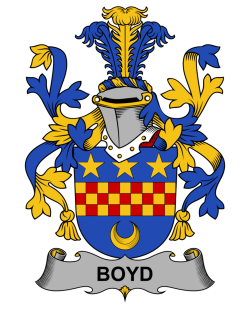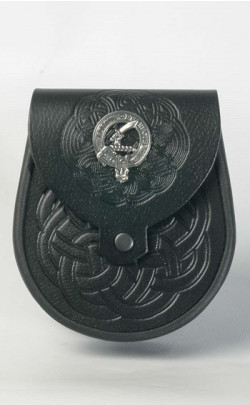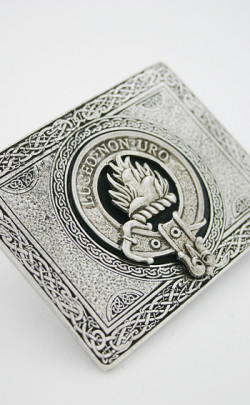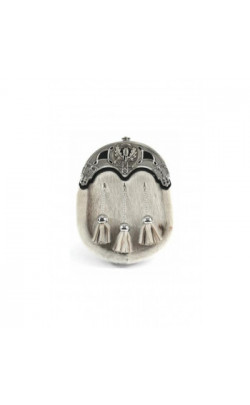
Scottish History
of Clan Boyd
In freedom’s defence
By the time they were raised to the peerage by James II in 1454, the Boyds had already played a significant role in Scotland’s history, not least through their selfless contribution to the cause of the Nation’s freedom in the bitter and bloody Wars of Independence with England.
Some sources assert the name stems from the Gaelic ‘buidhe’, meaning fair.
One tradition is that the original ancestor of today’s Boyds was Simon FitzAlan, known as Simon the Fair, who was either a nephew or a younger brother of Walter FitzAlan, the High Steward of Scotland who is recognised as the progenitor, or founder, of what became the Royal House of Stewart (or Stuart).
This explains why the Boyds, although a proud clan in their own right, are considered a sept, or branch, of the Stewarts, and why many today adopt the Royal Stewart tartan, although there is a Boyd sett.
Another explanation for the origin of the name Boyd is that it is a ‘location’ name, from the Gaelic ‘Boid’, referring to the island of Bute in the Clyde estuary.
Ayrshire became the homeland of the Boyds, with a Dominus Robertus de Boyd recorded as having witnessed a contract concerning the west coast town of Irvine in 1205.
This family of Boyds are thought to have been vassals of the powerful Anglo-Norman family of de Morville, but by the early thirteenth century they had risen to such prominence that they held their own lands in Ayrshire, particularly in the vicinity of Kilmarnock.
The Boyds appear to have been no sooner settled in Ayrshire than they found themselves embroiled in the cause of the nation’s freedom.
They rallied to its defence at the battle of Largs, when Sir Robert Boyd was among a group of Ayrshire lairds raised by Alexander FitzAlan, in his role as High Steward, to repel a Viking invasion that threatened after the king of Scots, Alexander III, laid claim to the Hebrides.
Warned that Alexander was prepared to wrest the islands from Norwegian control by force if necessary, King Hakon of Norway embarked with a mighty fleet from Bergen in July of 1263.
His fierce band of sea raiders plundered and ravaged Kintyre, Bute, and Islay, before appearing off the west coast mainland township of Largs.
A storm blew many of the vessels onto the shore beneath the overhanging Cunningham hills on the night of September 30, and it was on top of these hills that FitzAlan hastily assembled a force of militia that included Sir Robert Boyd and his kinsfolk.
A party of militia emerged from their high eminence the following morning and engaged in a skirmish with a band of Norsemen attempting to salvage precious cargo from their stricken vessels.
The Scots drove them back to their ships and returned that evening to gleefully loot the cargo.
Stung by the insult, King Hakon ordered a further attempt to retrieve the cargo the following day, October 1, resulting in what has become known as the battle of Largs but which in reality consisted of a series of disorganised skirmishes.
The Norsemen were driven back to their vessels, however, and King Hakon died a few weeks later in Kirkwall, Orkney: the threat to Scotland’s western seaboard in general and invasion of the mainland in particular had been averted.
The victory is commemorated annually at Largs with the ceremonial burning of a Viking longboat.
Intriguingly, while ‘I trust’ is the motto of the Boyds, and a right hand raised in benediction is the crest, several of the family’s coats of arms feature the word ‘Goldberry’.
This is thought to be in commemoration of Sir Robert Boyd who, with only a small band of men, fought and defeated a force of the invaders several miles south of the site of the main battle of Largs, at a location known as Goldberry, or Goldberry Hill.
More than forty years later, the Boyds found themselves at the forefront of the Wars of Independence after William Wallace raised the banner of revolt against the English occupation of Scotland in May of 1297.
An expert in the tactics of guerrilla warfare, Wallace and his hardened band of freedom fighters inflicted stunning defeats on the English garrisons, culminating in the liberation of practically all of Scotland following the battle of Stirling Bridge, on September 11, 1297.
Defeated at the battle of Falkirk on July 22, 1298, after earlier being appointed Guardian of Scotland, Sir William Wallace was eventually betrayed and captured in August of 1305, and, on August 23 of that year, he was brutally executed in London on the orders of a vengeful Edward I of England.
The bitter struggle continued under the leadership of the warrior king Robert the Bruce, however, and, in 1306, Duncan Boyd was killed by the English for swearing allegiance to him.
The struggle culminated in the battle of Bannockburn of June, 1314, when a 20,000-strong English army under Edward II was defeated by a Scots army less than half this strength.
Ironically, it was through a misguided sense of chivalry that the battle occurred in the first place.
By midsummer of 1313 the mighty fortress of Stirling Castle was occupied by an English garrison under the command of Sir Philip Mowbray.
Bruce’s hotheaded brother, Edward, rashly agreed to a pledge by Mowbray that if the castle was not relieved by battle by midsummer of the following year, then he would surrender.
This made battle inevitable, and by June 23 of 1314 the two armies faced one another at Bannockburn, in sight of the castle.
It was on this day that Bruce slew the English knight Sir Henry de Bohun in single combat, but the battle proper was not fought until the following day, shortly after the rise of the midsummer sun.
The English cavalry launched a desperate but futile charge on the densely packed ranks of Scottish spearmen known as schiltrons, and by the time the sun had sank slowly in the west the English army had been totally routed, with Edward himself only narrowly managing to make his escape from the carnage of the battlefield.
Scotland’s independence had been secured, to the glory of Bruce and his loyal army and at terrible cost to the English.
Sir Robert Boyd had been among Bruce’s most able commanders at Bannockburn, and was rewarded with lands in Ayrshire that Bruce confiscated from his rivals, the Balliols, with Dean Castle, in Kilmarnock, becoming the main family seat.
Other branches of the family also flourished in Ayrshire, as the Boyds of Merton, Penkiln, Pitcon, and Trochrig.
Now a popular tourist attraction, Dean Castle and its surrounding estate are now in the care of the East Ayrshire local authority.
As the power and influence of the Boyds increased following their elevation to the peerage in 1454, so to did their ambitions – and this was to prove fatal to their fortunes.
Kidnapping and execution
Following the death of James II in July of 1460, Lord Boyd of Kilmarnock was appointed one of the regents of the young James III.
By 1466, his brother, Sir Alexander Boyd, held the powerful posts of Chamberlain of the Royal Household and governor of Edinburgh Castle, while his son, Thomas, held the influential post of the king’s instructor in the military arts.
Consolidating their power, the Boyds actually kidnapped the king, persuading him to ratify an Act of Parliament that made them the sole guardians of the kingdom.
Their grip on the realm was further strengthened when Thomas Boyd married the king’s sister, the Princess Mary, and assumed the titles of Earl of Arran and Kilmarnock.
But pressure from a powerful group of rival nobles eventually led in November of 1469 to the Boyds being summoned before the king and Parliament to answer charges of treason.
Sir Alexander was executed, while Lord Boyd escaped to England and the Earl of Arran fled into exile in the Low Countries, where he died.
The Earl of Arran’s marriage to the Princess Mary had been annulled, and all the Boyd estates and honours were forfeited – but they were restored again during the reign from 1542 to 1567 of Mary, Queen of Scots.
A later Lord Boyd was a staunch supporter of the ill-starred queen, fighting for her cause at the decisive battle of Langside on May 13, 1568.
The queen had escaped from Lochleven Castle, in which she had been imprisoned after being forced to sign her abdication by a body known as the Confederate Lords.
Lord Boyd was among a group of nobles, bishops, lairds, and others who signed a bond declaring their support for her, and they and their forces met an army raised by the Confederate Lords at Langside, on the southern outskirts of Glasgow.
Mary’s forces, under the command of the Earl of Argyll, had been en route to the mighty bastion of Dumbarton Castle, atop its near inaccessible eminence on Dumbarton Rock, on the Clyde, when it was intercepted by a numerically inferior but tactically superior force led by her half-brother, the Earl of Moray.
Cannon fire had been exchanged between both sides before a force of Argyll’s infantry tried to force a passage through to the village of Langside, but they were fired on by a disciplined body of musketeers and forced to retreat as Moray launched a cavalry charge on their confused ranks.
The battle proved disastrous for Mary and signalled the death knell of her cause, with more than 100 of her supporters killed or captured and Mary forced to flee into what she then naively thought would be the protection of England’s Queen Elizabeth.
Lord Boyd later showed his devotion to his queen by visiting her periodically during the long exile she spent in England before her eventual execution in the Great Hall of Fotheringhay Castle, in Northamptonshire, in February of 1587.
Although the third Earl of Kilmarnock took the side of the Hanoverian government in the abortive Jacobite Rising of 1715, William, the fourth earl, proved loyal to the Jacobite cause in the 1745 Rising, eventually paying the ultimate price for his adherence to the cause.
Prince Charles Edward Stuart had arrived on the small Outer Hebridean island of Eriskay on July 22, 1745, landing on the mainland at Loch nan Uamh three days later.
The Stuart Standard was raised on August 19, at Glenfinnan, on Loch Shiel, and victory was achieved at the battle of Prestonpans, on the outskirts of Edinburgh, in September.
The confident prince and his army set off on the long march south to London a month later, to claim what was believed to be the rightful Stuart inheritance of the throne.
The army reached only as far as Derby, however, before the controversial decision was taken in early December to withdraw back over the border.
Jacobite hopes were later dashed forever - at the battle of Culloden, fought on Drummossie Moor, near Inverness, on April 16, 1746.
In what was the last major battle fought on British soil, hundreds of clansmen died on the battlefield while hundreds of others died later from their wounds and the inhumane treatment of their government captors.
Although two of his sons were serving in the government ranks, the 40-year-old earl had joined the prince in Edinburgh and raised a troop of cavalry known as Kilmarnock’s Horse.
They had advanced with the Jacobite army as far as Derby and were present at the battle of Falkirk on January 17, 1746.
Wounded and taken prisoner at Culloden, the abject Lord Boyd was being led bareheaded along the lines of the victorious Hanoverian army when his eldest son, who was serving as an ensign in the government forces, spotted the plight of his father and rushed forward to give him his own hat.
Imprisoned in the Tower of London, Lord Boyd was brought to trial for treason on July 28, 1746.
The statesman Horace Walpole, who was present throughout the trial, left a portrait for posterity of Lord Boyd, describing him as ‘tall and slender, with an extreme fine person; his behaviour a most just mixture between dignity and submission.
‘If in anything to be reprehended, a little affected, and his hair too exactly dressed for a man in his station; but when I say this it is not to find fault with him, but to show how little fault there is to be found.’
Pleading guilty, he threw himself on the mercy of the court, stressing that he had opted to surrender, rather than attempt to escape from the battlefield, but this proved to be of no avail: his head fell under the executioner’s axe on Tower Hill on August 18, 1746.
The Boyd titles were forfeited, but Lord Boyd’s eldest son, through his mother, succeeded to the earldom of Erroll in 1758, and took the surname of Hay.
It was not until 1941 that a brother of the 22nd Earl of Erroll again assumed the proud name of Boyd and the title of Lord Kilmarnock.
Family History Mini Book
We hope you enjoyed reading this excerpt from this mini book on the Scottish history of the Boyd family.
You can buy the full book for only108 Clan Boyd
Tartan Products
The Crests
of Clan Boyd































































